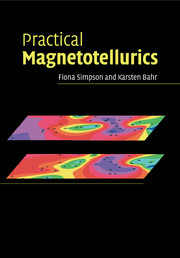Book contents
- Frontmatter
- Contents
- Preface
- Symbols
- 1 Introduction
- 2 Basic theoretical concepts
- 3 Planning a field campaign
- 4 From time series to transfer functions: data processing
- 5 Dimensionality and distortion
- 6 Numerical forward modelling
- 7 Inversion of MT data
- 8 The general link to other geosciences: conduction mechanisms
- 9 The special link to other geosciences
- 10 Other EM induction techniques
- Appendix 1 Theorems from vector calculus
- Appendix 2 The transfer function in the wavenumber-frequency domain and equivalence transfer functions
- Appendix 3 Probability distributions
- Appendix 4 Linear regression
- Appendix 5 Fourier analysis
- Appendix 6 Power and cross spectra
- Glossary
- References
- Index
6 - Numerical forward modelling
Published online by Cambridge University Press: 03 December 2009
- Frontmatter
- Contents
- Preface
- Symbols
- 1 Introduction
- 2 Basic theoretical concepts
- 3 Planning a field campaign
- 4 From time series to transfer functions: data processing
- 5 Dimensionality and distortion
- 6 Numerical forward modelling
- 7 Inversion of MT data
- 8 The general link to other geosciences: conduction mechanisms
- 9 The special link to other geosciences
- 10 Other EM induction techniques
- Appendix 1 Theorems from vector calculus
- Appendix 2 The transfer function in the wavenumber-frequency domain and equivalence transfer functions
- Appendix 3 Probability distributions
- Appendix 4 Linear regression
- Appendix 5 Fourier analysis
- Appendix 6 Power and cross spectra
- Glossary
- References
- Index
Summary
Suppose that after applying some of the tests suggested in the last chapter, we have computed ‘undistorted’ transfer functions and we infer that for a part of the target area (or for a limited period range) a 2-D interpretation of the conductivity distribution may be adequate, but that treating the target area in its entirety requires a 3-D interpretation. This is exactly the information that is required now, in order to decide which numerical modelling scheme should be applied for the purpose of generating synthetic transfer functions that can be compared with the measured ones. Most modelling schemes divide a 1-, 2- or 3-D world into blocks or cells and allow the user to choose the conductivity within each individual cell. Maxwell's equations are then solved within each cell, while certain boundary and continuity conditions are observed. Here we restrict ourselves to practical hints for those users who intend to apply existing modelling schemes to their data. There is an excellent book on the subject (Weaver, 1994) for those who wish to write their own modelling code. Some words of caution: choosing the conductivity inside some cells is somewhat arbitrary, because a change does not affect the calculated transfer functions significantly. Modelling experts explore the relationship between model changes and result changes with ‘sensitivities’. Obviously, more than one realisation of the model has to be computed before a small misfit (a normalised difference between field transfer functions and the modelled ones) is found.
- Type
- Chapter
- Information
- Practical Magnetotellurics , pp. 117 - 129Publisher: Cambridge University PressPrint publication year: 2005



